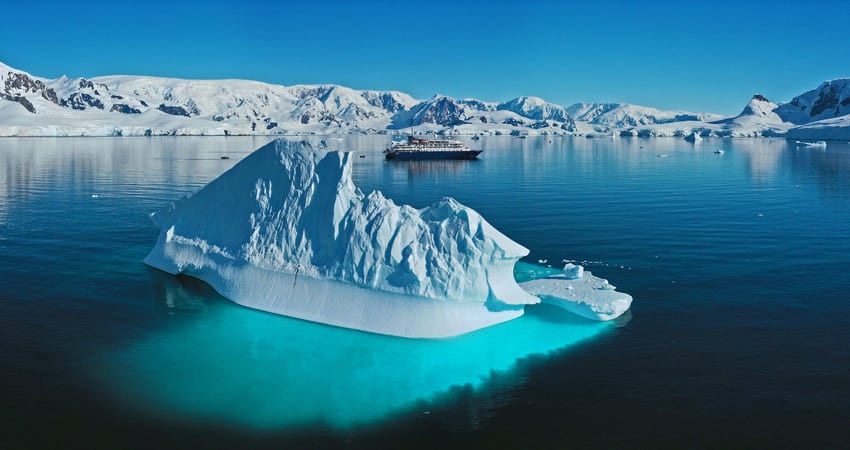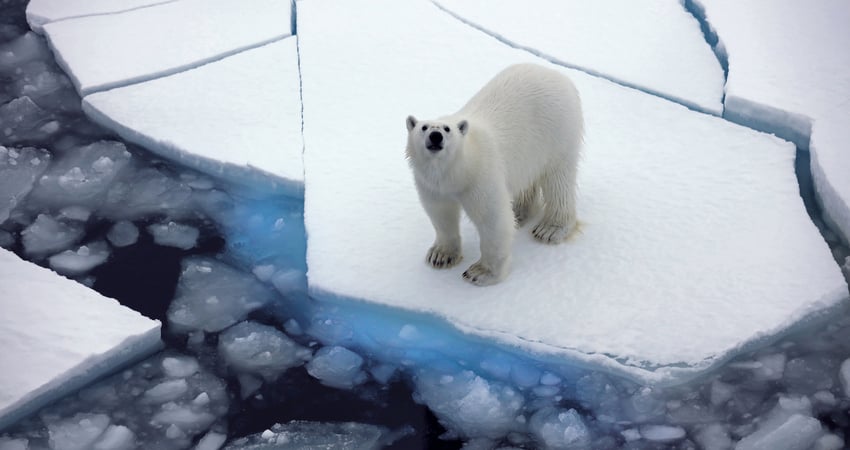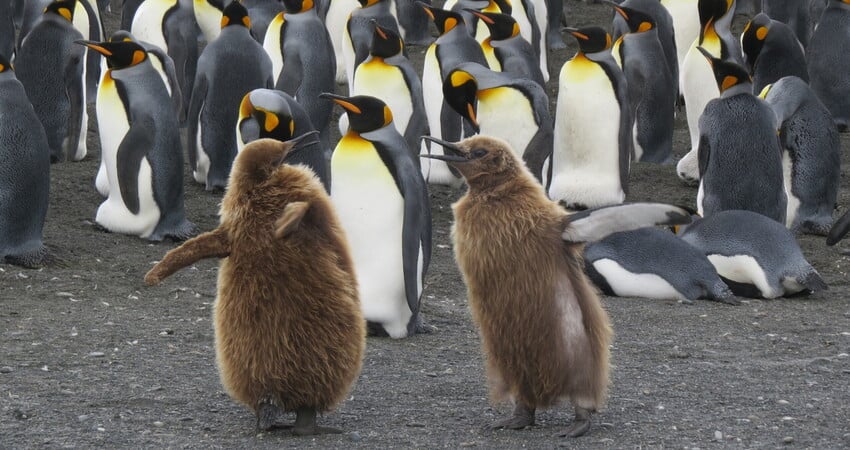Arctic vs Antarctic: What is the Difference?

Why do polar bears not eat penguins and where can you see the biggest icebergs? Be sure to know your polar regions before you choose your expedition cruise! While both poles will charm you with their incredible beauty, there are certain things to consider to make it the unforgettable experience of a lifetime.
Which wildlife is a must-see for you?
For majestic polar bears in their natural habitat, you’ll have to venture to the Arctic. You’ll also only see reindeer, walruses and arctic foxes on our north-bound cruises to Svalbard, Greenland and Iceland. But if all kinds of penguins and pinnipeds such as crabeater, weddell and elephant seals are your passion, then Antarctica is your destination!
What time of the year will you travel?
Planning your adventure cruise anytime from May to September? Then join us for the Arctic summer! Sea ice is receding and cruising the beautiful gems of the north will be possible. For the best opportunities to spot northern lights, we’ve put together a unique East Greenland cruise in September. If you’re looking for an adventure during the Antarctic summer months (November to February), we’ll take you south. We even have a Christmas and New Year cruise to Antarctica in case you’re looking for an extra special way to celebrate the holidays!
Follow your favorite polar explorer!
History buffs may want to explore and follow in the footsteps of their favorite polar expedition heroes! Want to see the iconic places of Sir Ernest Shackleton’s heroic adventures in the Southern Ocean? Board our Antarctic Peninsula and South Georgia cruises. You’ll see Elephant Island, where his crew had to spend a gruesome winter until rescue arrived, and you also get to visit his grave in South Georgia. Learn during our onboard lectures about Amundsen and Scott’s race to the South Pole or peak into our well-stocked polar library onboard. If you’re cruising to the Arctic, you’ll follow explorers like Nansen, Cook and Peary on their race to the North Pole. Visit historic sites and understand the hardships these explorers had to endure from the comfort of your modern expedition ship!
Can’t quite decide yet? Keep reading and find out about what makes the Arctic and Antarctica unique.
Basic Distinctions
|
ARCTIC |
ANTARCTICA |
|---|---|
|
Polar territory above 66.5 degrees north |
Polar territory below 66.3 degrees south |
|
Comprises the Arctic Ocean and land belonging to the northern parts of Scandinavia, Russia, Greenland, Canada and the US |
Comprises the Southern Ocean, the continent of Antarctica and subantarctic islands |
|
Governed by the 8 countries present in the region: Norway, Sweden, Finland, Russia, the US, Canada, Denmark and Iceland |
Governed by 54 nations under the Antarctic Treaty (signed Dec 1st, 1959 and enforced from June 23rd, 1961) |
|
A territory covered by sea ice, which recedes and grows with the seasons |
A continent 98% covered by a thick ice cap, with mountains as high as 4,892m/16,050 feet (Vinson Massif) |
|
Inhabitants: around 4 million people |
No permanent inhabitants (people from 29 nations work in currently ca. 70 permanent research bases in Antarctica) |
|
Prime time to visit: May - September |
Prime time to visit: October – April |
|
Iconic wildlife: polar bear, walrus, reindeer, arctic fox, musk ox, arctic hare and rare seabirds |
Iconic wildlife: penguins, weddell, crabeater and elephant seals, as well as an abundance of rare seabirds |
Is there Land under Antarctica?
While you are only able to see a very small percentage of the large landmass hidden under the immense ice cap of Antarctica, it consists of a very diverse topography. Imagine valleys, high mountains, rivers, lakes and active volcanos, with some of them covered by up to 4km (ca. 13,100 ft) of thick ice. And while it’s hard to believe, around 90 million years ago Antarctica was actually covered by a lush forest.
Difference between Ice Cover
Not all sea ice is alike. Sea ice in the Arctic doesn’t move as much across the surface as in Antarctica, since the Arctic Ocean is semi-enclosed by land. Not all sea ice melts up north during the summer months and new ice grows onto old ice with each season, piling up into ridges. Some of it may even sustain for up to 10 years, but with the gradually warming climate more and more ice melts with each summer season.
.jpg)
This in turn causes much larger areas of new and thin ice to form during the winter months, which moves much faster than thick ice floes. This trend is prone to transport and spread pollutants and microplastics much faster across the Arctic regions. Another negative impact on the Arctic Ocean ice is the use of fossil fuels and aerosols, which is linked to a continuous reduction in volume of Arctic ice since 1979. The Antarctic continent is surrounded by sea ice, which extends to the north each winter and recedes toward the coast during the Antarctic summer months. During the winter this effectively doubles the size of the White Continent!
Thickness Facts
Sea ice around the White Continent tends to be thinner. Not being sheltered and circled by a landmass like in the Arctic, Antarctic sea ice isn’t able to grow as thick. On average it reaches around 1-2 meters (3-6 ft) thickness, whereas Arctic sea ice measures 2-3 meters (6-9 ft) in thickness, with records of up to 5 meters (15 ft) in some regions. Another reason for the Arctic sea ice to be thicker is the continuous flow of fresh water to the Arctic Ocean through numerous rivers from Russia and Canada. With this layer of cold fresh water near the ocean surface and saltier water below, it allows for more sea ice growth than in Antarctica.
Antarctic Ice is Growing
While most scientist worry about melting glaciers and sea ice, the eastern Antarctic Peninsula ice sheet has actually been growing for the last 20 years. Up to 2002, the ice shelf’s exposure to ocean and waves caused excessive calving. But changing wind conditions in the Weddell Sea started to push sea ice against the ice shelves, building them back up. While some scientists believe that this trend could increase further, others predict a return to the former wind patterns and thus a decrease of Antarctic sea ice.
Icebergs
Get your cameras ready! Regardless of whether you’re heading north or south, you will see incredible iceberg formations floating in the ocean. If you’re looking for the biggest pieces then you should consider Antarctica. In 2017 the largest iceberg discovered in the world broke off an ice shelf in West Antarctica with a size of around 2.200m2 (23.680 square feet).
.jpg)
Which is colder – the Arctic or Antarctica?
A large ice sheet covering around 14 million m2 (5.4 million square miles) and with an average elevation of around 3,000m (9,800 ft) makes Antarctica the colder polar region. Add to that the high winds that sweep over the icy plains of Antarctica, and you’ll understand why most travelers come during the Antarctic summer months. The world record of the lowest air temperature ever recorded was at the research station Vostok in Antarctica, with -89°C (-128°F). If you do plan a trip to Antarctica don’t worry about freezing, you won’t be exposed to such subzero temperatures. If you board a cruise during the Antarctic summer (November-February) you’ll most likely experience temperatures around 0-12°C (ca. 32-53°F). Summer temperatures in the Arctic are comparable to this at around 7°C (ca. 44 °F) in July.
Wildlife
If you’re looking for a greater diversity of wildlife, then the Arctic is best for you. On average more species are endemic to the Arctic region, since it’s connected to the North American, European and Asian continents. But all depends on what iconic wildlife you want to see. While you’re likely spot narwhal, polar bears and walruses on your Arctic expedition cruise, you won’t see penguins, weddell, crabeater and elephant seals anywhere but in Antarctica. And did you know that, despite its harsh climate, the White Continent is home to a wingless insect called the Belgica Antarctica (Antarctic midge)?
Animals
Wherever you choose to cruise, north or south, you’ll find plenty of wildlife that will amaze you. But there are some endemic species to look out for in each polar region. While in the Arctic, look for iconic land animals such as polar bears, reindeer, musk ox, arctic terns, arctic hares, lemmings, arctic foxes and snowy owls. For marine animal lovers, there are species such as walrus, narwhals and various seals (bearded, harp, ringed, spotted and hooded).

Antarctica hosts a greater variety of marine animals, given its harsh climate and the inhabitable, krill-rich waters surrounding the continent. Be prepared to see an abundance of penguins (adélie, chinstrap, gentoo, king, rockhopper, macaroni and emperor), seals (crabeater, leopard, fur, weddell and elephant) and a variety of rare sea birds such as albatross and petrels. While some species made it to the White continent thanks to historic expeditions, the only endemic land animal is actually a wingless insect (Belgica Antarctica). Certain species have been introduced to Antarctica and the subantarctic islands during the heydays of exploration such as mice, rats, reindeer, cattle and sheep.

On each cruise, we’ll have wildlife specialists aboard who will tell you everything you want to know about the animals you spot. Head onto the bridge and pick up your binoculars to look for rare sea birds, or stop by the library to learn more about your favorite polar species!
You can spot wildlife at a safe distance from aboard our comfortable small expedition ship, the Sea Spirit. Get a closer look during excursions in small inflatable Zodiac boats, nature hikes or sea kayak journeys. We always respect wildlife and follow the AECO’s wildlife guidelines.
Plants
It’s the blooming tundra what makes summers in the Arctic so picturesque and beautiful. The treeless territory covering approximately 11,5 million km2, with a majority of it underlain by permafrost, feeds a variety of herbivores endemic to the Arctic. Expect a landscape framed by low growing shrubs (ca. 2m/7feet), grass, moss, lichen and a variety of flowering plants similar to those you can find in alpine territories.
See a small selection of the iconic Arctic plants that you can see on your expedition cruise to the northern polar regions:
Tufted saxifraga:
This beautiful flower with white petals blooms from July to August and reaches a height of just about 5-15cm (2-6 inches).
Arctic cotton grass:
Dotting the beautiful polar landscape with fluffy white cotton balls, this plant reaches a height of about 30cm (12 inches). It blooms in mid-summer and grows in swampy areas. And did you know that cotton grass mixed with seal fat was used by indigenous people of the north as candles?
Arctic draba:
With hairy green stems and bright yellow flowers, this species likes to grow in clusters on rocky and graveled grounds.
Arctic parraya:
This flower, which blooms from June to July, gives the Arctic beautiful hues of pinkish-purple shades.
Svalbard poppy:
This species of poppies comes in colors of either yellow or white and is the symbolic flower of Svalbard. It grows to a height of about 10-25cm (ca. 3-9 inches).
.jpg)
If you enjoy diverse flora, Antarctica may be a bit of a disappointment. Only 1% of the White Continent is free of ice, and you can find plants mostly on the subantarctic islands and parts of the Antarctic Peninsula. Among the few resilient species in Antarctica, there are around 100 species of moss, 300-400 types of lichens and grasses.
In both polar regions phytoplankton is present. This microalga uses the sunlight for photosynthesis, the nutrient rich oceans for sustenance and is a very important producer of the world’s oxygen!
Landscape Difference
One major difference between the Arctic and Antarctica is the location of the poles. The North Pole (90 degrees north) is located in the ocean covered by sea ice, whereas the South Pole lies on the continent of Antarctica. Antarctic sea ice does not extend inland all the way to the South Pole and usually reaches only the Ross and Weddell seas at around 75 degrees south.
Mountaineers and alpine fanatics may want to compare which polar region features the highest peaks. Antarctica’s highest peak, Mount Vinson (4.892m/16.050ft), exceeds the highest point in the Arctic, Mount Gunnbjörn (3,694m/12,119ft), which is located in Greenland.
Which way to go as a wildlife lover? With an accessible landmass and a variety of plant life in the Arctic tundra, you can find a greater amount of land animal species than in Antarctica. Since a majority of the White Continent is covered by ice, Antarctic wildlife evolves mostly around the sea, with a greater variety of marine animals such as whales, seals and penguins.
How important is history and culture for your perfect polar adventure? While indigenous human inhabitation shaped the Arctic for centuries with numerous settlements and historical sites, Antarctica features mostly research bases and the remains of historic explorers and whalers.
.jpg)
FAQ
Is Antarctica north or south?
Antarctica is located in the Southern Hemisphere. Travelers usually board expedition ships in Ushuaia, Argentina and cruise south to the Antarctic Peninsula and the subantarctic islands.
Are polar bears in the Arctic or Antarctic?
Polar bears are the iconic wildlife of the Arctic. You can see them in Svalbard, Greenland, Franz Josef Land and while cruising to the North Pole.
Which is bigger, the Arctic or Antarctic?
At approximately 14.5 million km2 (5.5 million square miles), the Arctic covers a slightly larger area than Antarctica. Antarctica in comparison covers an area about twice the size of the Australian continent (14.2 million km2/5.4 million square miles).